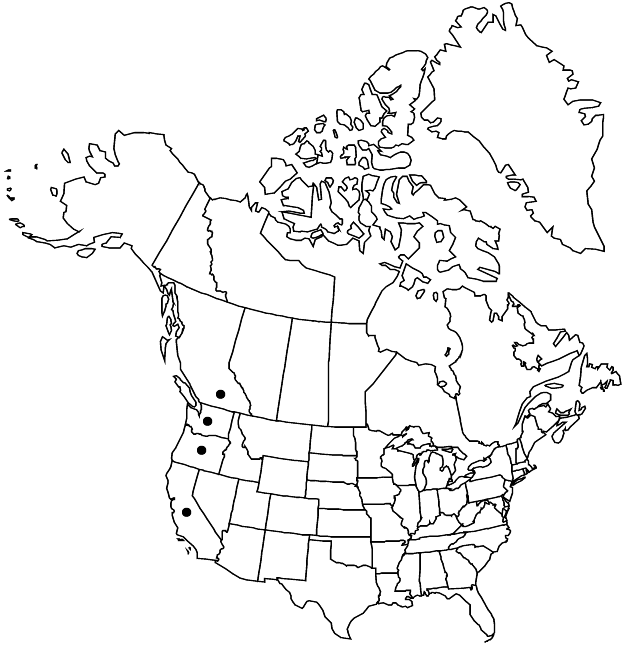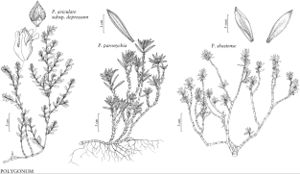Difference between revisions of "Polygonum paronychia"
Linnaea 3: 51. 1828.
FNA>Volume Importer |
imported>Volume Importer |
||
| (6 intermediate revisions by 2 users not shown) | |||
| Line 8: | Line 8: | ||
}} | }} | ||
|common_names=Beach or black or dune knotweed | |common_names=Beach or black or dune knotweed | ||
| + | |special_status={{Treatment/ID/Special_status | ||
| + | |code=F | ||
| + | |label=Illustrated | ||
| + | }}{{Treatment/ID/Special_status | ||
| + | |code=E | ||
| + | |label=Endemic | ||
| + | }} | ||
|basionyms= | |basionyms= | ||
|synonyms= | |synonyms= | ||
| Line 24: | Line 31: | ||
|elevation=0-50 m | |elevation=0-50 m | ||
|distribution=B.C.;Calif.;Oreg.;Wash. | |distribution=B.C.;Calif.;Oreg.;Wash. | ||
| − | |discussion=<p>Polygonum paronychia may be cultivated in rock gardens in open sites with sandy soil.</p> | + | |discussion=<p><i>Polygonum paronychia</i> may be cultivated in rock gardens in open sites with sandy soil.</p> |
|tables= | |tables= | ||
|references= | |references= | ||
| Line 33: | Line 40: | ||
-->{{#Taxon: | -->{{#Taxon: | ||
name=Polygonum paronychia | name=Polygonum paronychia | ||
| − | |||
|authority=Chamisso & Schlechtendal | |authority=Chamisso & Schlechtendal | ||
|rank=species | |rank=species | ||
| Line 43: | Line 49: | ||
|habitat=Coastal sands, scrub along coast | |habitat=Coastal sands, scrub along coast | ||
|illustrator=Barbara Alongi | |illustrator=Barbara Alongi | ||
| + | |illustration copyright=Flora of North America Association | ||
|elevation=0-50 m | |elevation=0-50 m | ||
|distribution=B.C.;Calif.;Oreg.;Wash. | |distribution=B.C.;Calif.;Oreg.;Wash. | ||
| Line 48: | Line 55: | ||
|publication title=Linnaea | |publication title=Linnaea | ||
|publication year=1828 | |publication year=1828 | ||
| − | |special status= | + | |special status=Illustrated;Endemic |
| − | |source xml=https:// | + | |source xml=https://bitbucket.org/aafc-mbb/fna-data-curation/src/2e0870ddd59836b60bcf96646a41e87ea5a5943a/coarse_grained_fna_xml/V5/V5_1146.xml |
|subfamily=Polygonaceae subfam. Polygonoideae | |subfamily=Polygonaceae subfam. Polygonoideae | ||
|genus=Polygonum | |genus=Polygonum | ||
Latest revision as of 22:08, 5 November 2020
Shrubs or subshrubs. Stems prostrate or ascending, brown, branched, rooting at nodes, not wiry, 10–100 cm, glabrous, covered with remains of lacerate, hyaline ocreae. Leaves crowded at branch tips, articulated to ocreae, basal leaves caducous or persistent, distal leaves not reduced in size; ocrea 15–20 mm, glabrous, proximal part cylindric to funnelform, distal part silvery, entire or slightly lacerate, disintegrating into persistent white-gray curly fibers; petiole 0–0.5 mm; blade 1-veined, without pleats, linear to oblanceolate, (5–)10–20(–33) × 3–8 mm, coriaceous, margins revolute, smooth, apex acute or mucronate. Inflorescences axillary; cymes crowded in distal axils, 2–5-flowered. Pedicels enclosed in ocreae, erect to spreading, 2–5 mm. Flowers semi-open or open; perianth (4.5–)6–10 mm; tube 22–48% of perianth length; tepals partially overlapping, uniformly pink or white, reddish brown when dried, petaloid, oblong-ovate to ± lanceolate, apex rounded; midveins pinnately branched; stamens 8. Achenes enclosed in or slightly exserted from perianth, black, ovate, 4–5 mm, faces subequal, shiny, smooth.
Phenology: Flowering Mar–Sep.
Habitat: Coastal sands, scrub along coast
Elevation: 0-50 m
Distribution

B.C., Calif., Oreg., Wash.
Discussion
Polygonum paronychia may be cultivated in rock gardens in open sites with sandy soil.
Selected References
None.
